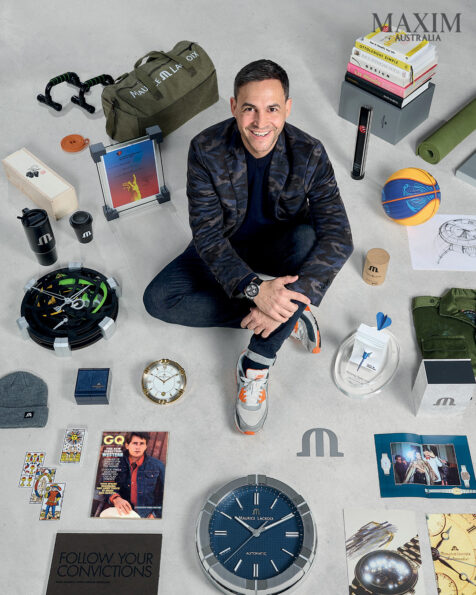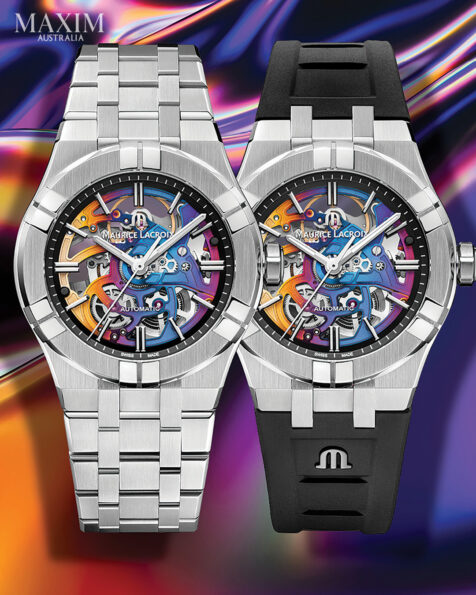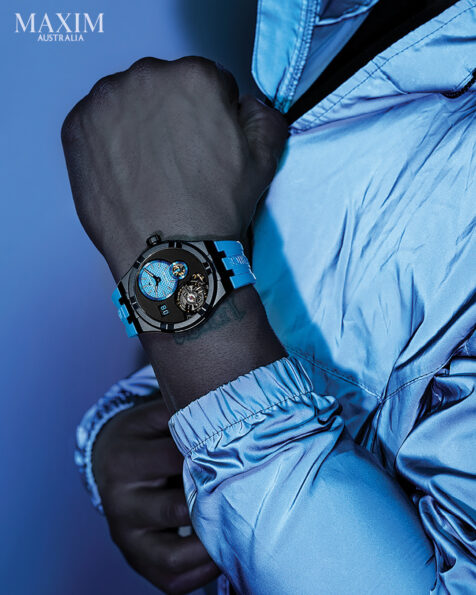A conversation with Maurice Lacroix’s managing director STÉPHANE WASER to celebrate 50 years of Swiss watchmaking excellence…
More than anything else, Stéphane Waser wants Maurice Lacroix watches to feel like wise investments. Headquartered in Hölsteinaignelégier, located in the Franches Montagnes, Maurice Lacroix literally sits in the centre of Switzerland’s legendary watchmaking industry. The brand was founded in 1975 at the height of the quartz crisis but managed to rapidly expand over the following decades by offering high-end watches at more accessible prices than its competitors. At the helm of Maurice Lacroix since 2014, Waser has shepherded the independent Swiss watchmaker into a new era (and profitability) with a little help from the wildly successful Aikon watch.
Introduced in 2016, the steel-bracelet Aikon took inspiration from the brand’s earlier Calypso design and has become a firm favourite among watch collectors from Dallas to Delhi, largely through word-of-mouth. Like a Goyard bag or a Ferragamo loafer, part of the charm of a Maurice Lacroix watch is the brand’s independence from the conglomerates which have corporatised the business of making nice things.

While the likes of LVMH and Swatch Group have planted their ubiquitous boutiques on the poshest street of every major city, Maurice Lacroix remains mostly available through stockists. And though 50 years of history is relatively short in the pantheon of Swiss watchmakers, Maurice Lacroix more than punches above its weight among the Omegas and Rolexes. Today, Maurice Lacroix watches are extremely well-made, good-looking and have features and finishes you’ll struggle to find anywhere else in the $2,000 to $5,000 category. Here, Waser revisits five decades of innovation and reveals the top-secret next chapter for the brand which he’s been nonchalantly wearing on his wrist for the past month.

Hey Stéphane, congratulations on 50 years of Maurice Lacroix. What does the brand stands for today?
It’s been a nice half of a century and we’ve built a lot, but I think what is still true to our origins is the value and the quality, bringing nice watchmaking horology at very accessible prices and democratising this. We are one of the few brands at our price point that do quartz, we do mechanical, and we also have our own movements. This doesn’t happen in a lot of brands.
The Aikon watch has such a cult following among collectors, what is it about this model that resonates with them?
The design team did a great job on the Aikon and that’s one part of it. And of course, quality was very important. Having the design know how in-house (is) why we’re capable of developing the Aikon. It makes it a great looking watch, a very highly qualitative watch in terms of perception, and all this together with the strong design base we have, this has really contributed to making the Aikon a great success.

When it comes to your personal watch, what’s on your wrist at the moment?
I have something on the wrist at the moment, which will come out in two or three months. It’s an extension of the Aikon, but it’s called Aikonic and the ‘IC’ stands for innovative craftsmanship. So, we’re pushing the boundaries here in terms of materials, technique, wearability and functionality. It’s a strong next card we play, and I’ve been wearing it now for about a month.
Maurice Lacroix has a diverse list of “friends of the brand”. What does the brand look for when selecting an athlete or creative?
First and foremost, they have to really be friends. So, it’s about authenticity. We work with people who really want to work with us – it’s not about the money, it’s about the projects, it’s about the mutual benefits and that’s how we selected these people and how some of these people have selected us. You also feel it, you know, in the way they speak about the brand, the way they share the brand on their social networks. It’s not about contacting people and asking them for five posts, giving that amount of money and off you go. If that happens usually that’s when we say we’re not interested. That’s not the brand; that’s not the spirit.

Do projects like the Aikon Tide watch (made from ocean plastic) help open the brand to younger customers?
Yeah, that was definitely one of the ideas for doing such a project because there was a request from this upcoming generation, not necessarily recycling, but the sustainability of the watch. What can you offer? So, you know, it’s a lot about listening to your customers. We have contacts with our retailers but also people can write us an email and you will get an answer, we will give you feedback. I mean, we will listen to you, and we will also respond. Things have changed – 10-15 years ago brands were really dictating the design and the products and the consumption. Today, customers want to be part of it, they want to contribute and they’re very specific and they’re vocal about what they expect and what they need. So you’ve got two solutions: you listen, or you don’t.
What do you think is the defining story of Maurice Lacroix over the past 50 years?
This brand was actually launched in the middle of the quartz crisis of the ’70s and has been growing stronger and stronger year after year. Even though we’ve been so successful, it is interesting to see how many people still don’t know the story and how much potential we still have to grow.
In Australia, Maurice Lacroix is available through authorised retailers. Would you look to open more of your own boutiques around the world in future?
We’ve got globally three boutiques now. The thing is we don’t have a boutique strategy. We are really a multi-brand partner and so we really rely on strong vital partners to pick up the brand. This is certainly a point we have to work on in Australia to upgrade and get more excitement on the retail sites to better serve the customers.
Shop Maurice Lacroix timepieces at authorised retailers and www.mauricelacroix.com
By REILLY SULLIVAN
For the full article grab the June 2025 issue of MAXIM Australia from newsagents and convenience locations. Subscribe here.



